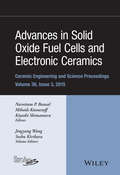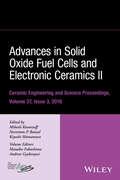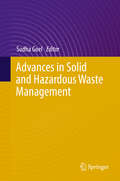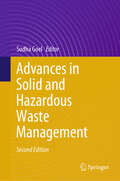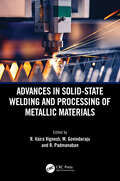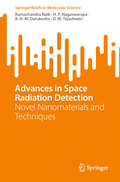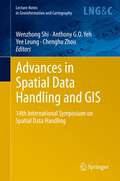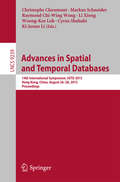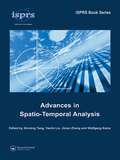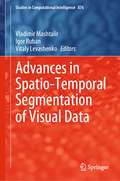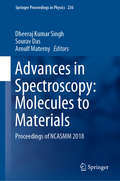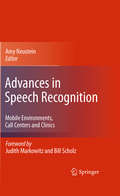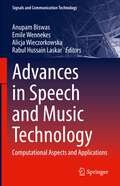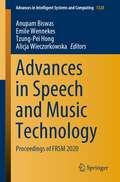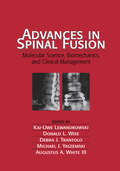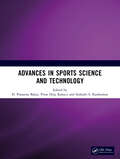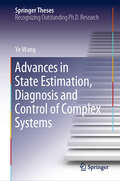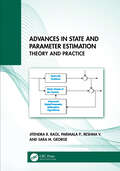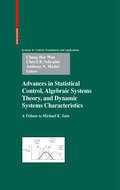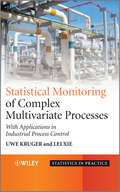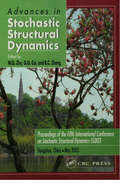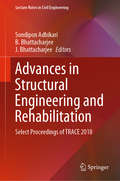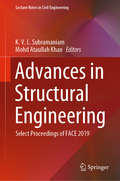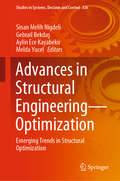- Table View
- List View
Advances in Solid Oxide Fuel Cells and Electronic Ceramics
by Narottam P. Bansal Soshu Kirihara Jingyang Wang Mihails Kusnezoff Kiyoshi ShimamuraThis book is a collection of papers from The American Ceramic Society's 35th International Conference on Advanced Ceramics and Composites, held in Daytona Beach, Florida, January 23-28, 2011. This issue includes papers presented in the 8th International Symposium on Solid Oxide Fuel Cells: Materials, Science, and Technology on topics such as Cell and Stack Development; Electrochemical/Mechanical/Thermal Performance; Electrodes; Interconnects; Novel Cell/Stack Design and Processing; and Reliability/Degradation.
Advances in Solid Oxide Fuel Cells and Electronic Ceramics II
by Narottam P. Bansal Mihails Kusnezoff Kiyoshi Shimamura Manabu Fukushima Andrew GyekenyesiThis issue contains 13 papers from The American Ceramic Society’s 40th International Conference on Advanced Ceramics and Composites, held in Daytona Beach, Florida, January 24-29, 2016 presented in Symposium 3 - 13th International Symposium on Solid Oxide Fuel Cells: Materials, Science, and Technology and Symposium 14 – Single Crystalline Materials for Electrical, Optical, and Medical Applications.
Advances in Solid and Hazardous Waste Management
by Sudha GoelThis book presents reviews, examples and case studies of innovative applications in solid and hazardous waste management. The economics of waste management have since become a significant research area in their own right, and two chapters address these issues. In addition, dedicated chapters cover specific categories of waste such as biomedical and institutional waste, plastics and e-waste. The book subsequently discusses newer analytical methods like SEM, EDX, XRD and optical microscopy, along with selected "older" methods for sampling and characterizing different types of waste. The various applications of mathematical tools like linear optimization, various software/models like WISCLeach, and DRASTIC, and tools like remote sensing and GIS are illustrated in many of the chapters. Lastly, since composting is one of the most popular treatment methods for managing the organic component of municipal solid waste, the book provides an overview of composting and the fundamentals of microbiology that are essential to understanding waste-related biological processes. The book was primarily written for students and practitioners in the field who are already familiar with the basics. All chapters were prepared by practicing experts and scholars in the field, and are intended to help readers better understand and apply these principles and practices in their own endeavours. Key topics covered in the book: * The circular economy and the economics of solid waste management * Various remote sensing and GIS applications for managing municipal solid waste, coal fires in mines, changes in land use and land cover in industrial areas, etc. * Treatment and management of different types of solid waste: institutional (including biomedical), residential, e-waste, plastic, and ash from thermal power plants * Sampling and characterization of municipal waste and compost * Fundamentals of microbiology * Overview of environmental regulations, especially those pertaining to solid and hazardous waste management
Advances in Solid and Hazardous Waste Management
by Sudha GoelThis book provides the reader with topical applications of innovative tools for better solid and hazardous waste management. Separate sections have been compiled for both traditional and new solid waste categories with examples and case studies in all of them. Various physical, chemical and biological processes can be used for segregation and treatment of these wastes and some advanced methods are covered in this book. Advances in laboratory analytical methods, mathematical tools, remote sensing and GIS have been successfully applied to finding solutions to many problems in this field.
Advances in Solid-State Welding and Processing of Metallic Materials
by R. Vaira Vignesh R. Padmanaban M. GovindarajuThis book covers the essential information needed to understand the latest developments of solid-state welding and processing of metallic materials, including physical metallurgy, production technologies, alloy development, compositing, post-processing, and joining methodologies.Advances in Solid-State Welding and Processing of Metallic Materials is the result of the collaborative efforts from expert researchers across various institutions around the globe. Harnessing this wealth of expertise and experience, the book enables the reader to comprehend both the theory behind microstructural evolution, as well as the practical elements of welding and processing. It also analyzes strengthening mechanisms, corrosion mechanisms, and wear mechanisms. Topics discussed in this book include friction stir welding, friction stir processing, modified friction stir clinching, hot-rolling and cold-rolling alongside diffusion bonding, and powder metallurgy processing. This book is a valuable companion to all students and researchers in metallurgy, materials science and engineering, manufacturing engineering, and production engineering.
Advances in Space Radiation Detection: Novel Nanomaterials and Techniques (SpringerBriefs in Molecular Science)
by H. P. Nagaswarupa Ramachandra Naik B. H. Darukesha D. M. TejashwiniThis brief explores the development and enhancement of space radiation detection systems through the integration of advanced nanomaterials, specifically focusing on metal oxide nanomaterials such as ZrO2. It covers the synthesis, characterization, and thermoluminescence properties of these nanomaterials, as well as their incorporation into plastic scintillators to improve detection efficiency. The book also discusses the challenges and advancements in creating reliable radiation detection technology for space exploration, highlighting potential applications and future directions in the field. It is a useful resource for scientists and graduate students involved in the fields of space exploration, radiation detection technologies, and nanotechnology.
Advances in Spatial Data Handling and Analysis: Select Papers from the 16th IGU Spatial Data Handling Symposium (Advances in Geographic Information Science)
by Yee Leung Francis HarveyThis book contains a selection of papers from the 16th International Symposium on Spatial Data Handling (SDH), the premier long-running forum in geographical information science. This collection offers readers exemplary contributions to geospatial scholarship and practice from the conference's 30th anniversary.
Advances in Spatial Data Handling and GIS: 14th International Symposium on Spatial Data Handling (Lecture Notes in Geoinformation and Cartography)
by Anthony G.O. Yeh Yee Leung Chenghu Zhou Wenzhong ShiThis book provides a cross-section of cutting-edge research areas being pursued by researchers in spatial data handling and geographic information science (GIS). It presents selected papers on the advancement of spatial data handling and GIS in digital cartography, geospatial data integration, geospatial database and data infrastructures, geospatial data modeling, GIS for sustainable development, the interoperability of heterogeneous spatial data systems, location-based services, spatial knowledge discovery and data mining, spatial decision support systems, spatial data structures and algorithms, spatial statistics, spatial data quality and uncertainty, the visualization of spatial data, and web and wireless applications in GIS.
Advances in Spatial and Temporal Databases: 14th International Symposium, SSTD 2015, Hong Kong, China, August 26-28, 2015. Proceedings (Lecture Notes in Computer Science #9239)
by Christophe Claramunt Markus Schneider Raymond Chi-Wing Wong Li Xiong Woong-Kee Loh Cyrus Shahabi Ki-Joune LiThis book constitutes the refereed proceedings of the 14th International Symposium on Spatial and Temporal Databases, SSTD 2015, held in Hong Kong, China, in August 2015. The 24 revised full papers together with 8 demos presented were carefully reviewed and selected from 64 submissions. The conference program has the scope on following subjects: reachability query and path query, reverse query and indexing, navigation and routing, trajectory analysis, spatio-temporal approaches, privacy and matching, similarity search and pattern, keyword and pattern.
Advances in Spatio-Temporal Analysis
by Xinming Tang Yaolin Liu Jixian Zhang Wolfgang KainzDevelopments in Geographic Information Technology have raised the expectations of users. A static map is no longer enough; there is now demand for a dynamic representation. Time is of great importance when operating on real world geographical phenomena, especially when these are dynamic. Researchers in the field of Temporal Geographical Infor
Advances in Spatio-Temporal Segmentation of Visual Data (Studies in Computational Intelligence #876)
by Vladimir Mashtalir Igor Ruban Vitaly LevashenkoThis book proposes a number of promising models and methods for adaptive segmentation, swarm partition, permissible segmentation, and transform properties, as well as techniques for spatio-temporal video segmentation and interpretation, online fuzzy clustering of data streams, and fuzzy systems for information retrieval. The main focus is on the spatio-temporal segmentation of visual information. Sets of meaningful and manageable image or video parts, defined by visual interest or attention to higher-level semantic issues, are often vital to the efficient and effective processing and interpretation of viewable information. Developing robust methods for spatial and temporal partition represents a key challenge in computer vision and computational intelligence as a whole.This book is intended for students and researchers in the fields of machine learning and artificial intelligence, especially those whose work involves image processing and recognition, video parsing, and content-based image/video retrieval.
Advances in Spectroscopy: Proceedings of NCASMM 2018 (Springer Proceedings in Physics #236)
by Dheeraj Kumar Singh Sourav Das Arnulf MaternyThis book presents and discusses recent developments in the broad field of spectroscopy, providing the reader with an updated overview. The main objective is to introduce them to recent innovations and current trends in spectroscopy applied to molecules and materials. The book also brings together experimentalists and theoreticians to highlight the multidimensional aspects of spectroscopy and discuss the latest issues. Accordingly, it provides insights not only into the general goals of spectroscopy, but also into how the various spectroscopic techniques represent a toolbox that can be used to gain a more detailed understanding of molecular systems and complex chemical problems. Besides technical aspects, basic theoretical interpretations of spectroscopic results are also presented. The spectroscopy techniques discussed include UV-visible absorption spectroscopy, Raman spectroscopy, IR absorption spectroscopy, fluorescence spectroscopy, and time-resolved spectroscopy. In turn, basic tools like lasers and theoretical modeling approaches are also presented. Lastly, applications for the characterization of fundamental properties of molecules (environmental aspects, biomolecules, pharmaceutical drugs, hazardous molecules, etc.) and materials (nanomaterials, nuclear chemistry materials, biomaterials, etc.) are discussed. Given its scope, the book offers a valuable resource for researchers from various branches of science, and presents new techniques that can be applied to their specific problems.
Advances in Speech Recognition: Mobile Environments, Call Centers and Clinics
by Amy NeusteinThis volume is comprised of contributions from eminent leaders in the speech industry, and presents a comprehensive and in depth analysis of the progress of speech technology in the topical areas of mobile settings, healthcare and call centers. The material addresses the technical aspects of voice technology within the framework of societal needs, such as the use of speech recognition software to produce up-to-date electronic health records, not withstanding patients making changes to health plans and physicians. Included will be discussion of speech engineering, linguistics, human factors analysis, medical informatics, business and information technology, electronics and communications engineering, all integrated into a cohesive work.
Advances in Speech and Music Technology: Computational Aspects and Applications (Signals and Communication Technology)
by Anupam Biswas Alicja Wieczorkowska Emile Wennekes Rabul Hussain LaskarThis book presents advances in speech and music in the domain of audio signal processing. The book begins with introductory chapters on the basics of speech and music, and then proceeds to computational aspects of speech and music, including music information retrieval and spoken language processing. The authors discuss the intersection in the field of computer science, musicology and speech analysis, and how the multifaceted nature of speech and music information processing requires unique algorithms, systems using sophisticated signal processing, and machine learning techniques that better extract useful information. The authors discuss how a deep understanding of both speech and music in terms of perception, emotion, mood, gesture and cognition is essential for successful application. Also discussed is the overwhelming amount of data that has been generated across the world that requires efficient processing for better maintenance, retrieval, indexing and querying and how machine learning and artificial intelligence are most suited for these computational tasks. The book provides both technological knowledge and a comprehensive treatment of essential topics in speech and music processing.
Advances in Speech and Music Technology: Proceedings of FRSM 2020 (Advances in Intelligent Systems and Computing #1320)
by Tzung-Pei Hong Anupam Biswas Alicja Wieczorkowska Emile WennekesThis book features original papers from 25th International Symposium on Frontiers of Research in Speech and Music (FRSM 2020), jointly organized by National Institute of Technology, Silchar, India, during 8–9 October 2020. The book is organized in five sections, considering both technological advancement and interdisciplinary nature of speech and music processing. The first section contains chapters covering the foundations of both vocal and instrumental music processing. The second section includes chapters related to computational techniques involved in the speech and music domain. A lot of research is being performed within the music information retrieval domain which is potentially interesting for most users of computers and the Internet. Therefore, the third section is dedicated to the chapters related to music information retrieval. The fourth section contains chapters on the brain signal analysis and human cognition or perception of speech and music. The final section consists of chapters on spoken language processing and applications of speech processing.
Advances in Spinal Fusion: Molecular Science, BioMechanics, and Clinical Management
by Kai-Uwe LewandrowskiAdvances in Spinal Fusion reveals a new generation of materials and devices for enhanced operations in spinal fusion. This reference showcases emerging research and technologies in areas such as biodegradable implants, drug delivery, stem cell isolation and transfection, cell encapsulation and immobilization, and the design of 2D and 3D scaffolds for cells. It captures a cascade of innovations crucial to increased healing and decreased morbidity in spinal fusion methods and mechanics and addresses current standards in analytical methodology and quality control, it describes the selection of biomaterials for improved biocompatibility, biostability, and structure/function relationships.
Advances in Sports Science and Technology
by D. Prasanna Balaji Pinar Dinç Kalayci Seshadri RamkumarIt focused on the strategies, challenges and choices in the renaissance of modern sports. It brought together scientists, sports persons, decision makers and executives from across the globe to share research approaches, methods and results. It analyzed ways for implementing adaptable and observable improvement which have direct impact on sports.
Advances in State Estimation, Diagnosis and Control of Complex Systems (Springer Theses)
by Ye WangThis book presents theoretical and practical findings on the state estimation, diagnosis and control of complex systems, especially in the mathematical form of descriptor systems. The research is fully motivated by real-world applications (i.e., Barcelona’s water distribution network), which require control systems capable of taking into account their specific features and the limits of operations in the presence of uncertainties stemming from modeling errors and component malfunctions. Accordingly, the book first introduces a complete set-based framework for explicitly describing the effects of uncertainties in the descriptor systems discussed. In turn, this set-based framework is used for state estimation and diagnosis. The book also presents a number of application results on economic model predictive control from actual water distribution networks and smart grids. Moreover, the book introduces a fault-tolerant control strategy based on virtual actuators and sensors for such systems in the descriptor form.
Advances in State and Parameter Estimation: Theory and Practice
by Jitendra R. Raol Parimala P. Reshma V. Sara M. GeorgeThis book deals with the basics of parameter estimation and state estimation as the fundamental building blocks of mathematical modelling activity in the broader field of control theory. All the methods are validated using MATLAB®-based implementations with realistically simulated data for general dynamic systems, as well as for aircraft parameter estimation. This book includes several illustrative examples and chapter-end exercises.Features: Provides comprehensive coverage of all issues related to parameter and state estimation. Discusses advanced topics related to Kalman filter, stability analysis, image centroid tracking and neural networks for parameter estimation. Explores convergence and stability results for the discussed methods. Reviews the estimation of parameters in linear/nonlinear models, and distributed fitting. Includes MATLAB®-based illustrative examples, and exercises. This book is aimed at researchers and graduate students in systems and control, signal processing, estimation theory, engineering mathematics, and aerospace engineering.
Advances in Statistical Control, Algebraic Systems Theory, and Dynamic Systems Characteristics: A Tribute to Michael K. Sain (Systems & Control: Foundations & Applications)
by Anthony N. Michel Cheryl B. Schrader Chang-Hee WonThis volume is a collection of chapters covering recent advances in stochastic optimal control theory and algebraic systems theory. The book will be a useful reference for researchers and graduate students in systems and control, algebraic systems theory, and applied mathematics. Requiring only knowledge of undergraduate-level control and systems theory, the work may be used as a supplementary textbook in a graduate course on optimal control or algebraic systems theory.
Advances in Statistical Monitoring of Complex Multivariate Processes
by Uwe Kruger Lei XieThe development and application of multivariate statistical techniques in process monitoring has gained substantial interest over the past two decades in academia and industry alike. Initially developed for monitoring and fault diagnosis in complex systems, such techniques have been refined and applied in various engineering areas, for example mechanical and manufacturing, chemical, electrical and electronic, and power engineering. The recipe for the tremendous interest in multivariate statistical techniques lies in its simplicity and adaptability for developing monitoring applications. In contrast, competitive model, signal or knowledge based techniques showed their potential only whenever cost-benefit economics have justified the required effort in developing applications.Statistical Monitoring of Complex Multivariate Processes presents recent advances in statistics based process monitoring, explaining how these processes can now be used in areas such as mechanical and manufacturing engineering for example, in addition to the traditional chemical industry.This book:Contains a detailed theoretical background of the component technology.Brings together a large body of work to address the field's drawbacks, and develops methods for their improvement.Details cross-disciplinary utilization, exemplified by examples in chemical, mechanical and manufacturing engineering.Presents real life industrial applications, outlining deficiencies in the methodology and how to address them.Includes numerous examples, tutorial questions and homework assignments in the form of individual and team-based projects, to enhance the learning experience.Features a supplementary website including Matlab algorithms and data sets.This book provides a timely reference text to the rapidly evolving area of multivariate statistical analysis for academics, advanced level students, and practitioners alike.
Advances in Stochastic Structural Dynamics: Proceedings of the 5th International Conference on Stochastic Structural Dynamics-SSD '03, Hangzhou, China, May 26-28, 2003
by W. Q. Zhu G.Q. CaiCollection of technical papers presented at the 5th International Conference on Stochastic Structural Dynamics (SSD03) in Hangzhou, China during May 26-28, 2003. Topics include direct transfer substructure method for random response analysis, generation of bounded stochastic processes, and sample path behavior of Gaussian processes.
Advances in Structural Engineering and Rehabilitation: Select Proceedings of TRACE 2018 (Lecture Notes in Civil Engineering #38)
by Sondipon Adhikari B. Bhattacharjee J. BhattacharjeeThis book comprises select papers presented at the International Conference on Trends and Recent Advances in Civil Engineering (TRACE 2018). The book covers a wide range of topics related to recent advancements in structural engineering, structural health monitoring, rehabilitation and retrofitting of structures, and earthquake-resistant structures. Based on case studies and laboratory investigations, the book highlights latest techniques and innovative methods for building repair and maintenance. Recent development in materials being used in structural rehabilitation and retrofitting is also discussed. The contents of this book can be useful for researchers and professionals working in structural engineering and allied areas.
Advances in Structural Engineering: Select Proceedings of FACE 2019 (Lecture Notes in Civil Engineering #74)
by K. V. L. Subramaniam Mohd Ataullah KhanThis book contains selected papers in the area of structural engineering from the proceedings of the conference, Futuristic Approaches in Civil Engineering (FACE) 2019. In the area of construction materials, the book covers high quality research papers on raw materials and manufacture of cement, mixing, rheology and hydration, admixtures, characterization techniques and modeling, fiber-reinforced concrete, repair and retrofitting of concrete structures, novel testing techniques such as digital image correlation (DIC). Research on sustainable building materials like Geopolymer concrete and recycled aggregates are covered. In the area of earthquake engineering, papers related to the seismic response of load-bearing unreinforced masonry walls, reinforced concrete frame and buildings with dampers are covered. Additionally, there are chapters on structures subjected to vehicular impact and fire. The contents of this book will be useful for graduate students, researchers and practitioners working in the areas of concrete, earthquake and structural engineering.
Advances in Structural Engineering—Optimization: Emerging Trends in Structural Optimization (Studies in Systems, Decision and Control #326)
by Gebrail Bekdaş Sinan Melih Nigdeli Aylin Ece Kayabekir Melda YucelThis book is an up-to-date source for computation applications of optimization, prediction via artificial intelligence methods, and evaluation of metaheuristic algorithm with different structural applications. As the current interest of researcher, metaheuristic algorithms are a high interest topic area since advance and non-optimized problems via mathematical methods are challenged by the development of advance and modified algorithms. The artificial intelligence (AI) area is also important in predicting optimum results by skipping long iterative optimization processes. The machine learning used in generation of AI models also needs optimum results of metaheuristic-based approaches.This book is a great source to researcher, graduate students, and bachelor students who gain project about structural optimization. Differently from the academic use, the chapter that emphasizes different scopes and methods can take the interest and help engineer working in design and production of structural engineering projects.
